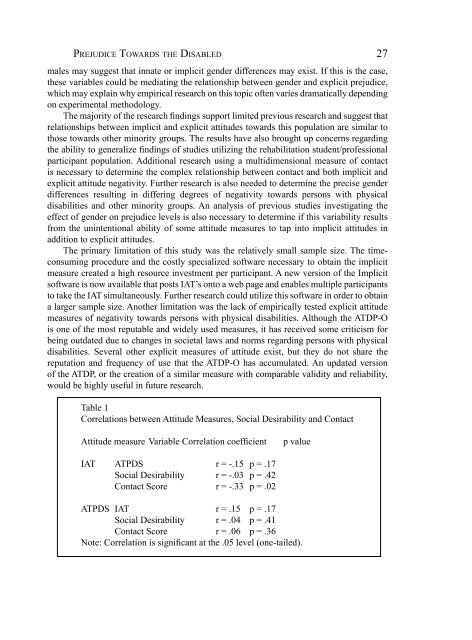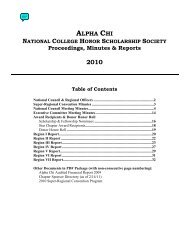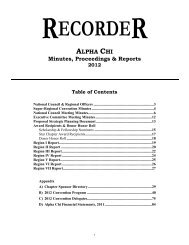Vol. 52, No. 1, 2009 - Alpha Chi
Vol. 52, No. 1, 2009 - Alpha Chi
Vol. 52, No. 1, 2009 - Alpha Chi
Create successful ePaper yourself
Turn your PDF publications into a flip-book with our unique Google optimized e-Paper software.
Pr e j u d i c e To wa r d s t h e Di s a b l e d<br />
males may suggest that innate or implicit gender differences may exist. If this is the case,<br />
these variables could be mediating the relationship between gender and explicit prejudice,<br />
which may explain why empirical research on this topic often varies dramatically depending<br />
on experimental methodology.<br />
The majority of the research findings support limited previous research and suggest that<br />
relationships between implicit and explicit attitudes towards this population are similar to<br />
those towards other minority groups. The results have also brought up concerns regarding<br />
the ability to generalize findings of studies utilizing the rehabilitation student/professional<br />
participant population. Additional research using a multidimensional measure of contact<br />
is necessary to determine the complex relationship between contact and both implicit and<br />
explicit attitude negativity. Further research is also needed to determine the precise gender<br />
differences resulting in differing degrees of negativity towards persons with physical<br />
disabilities and other minority groups. An analysis of previous studies investigating the<br />
effect of gender on prejudice levels is also necessary to determine if this variability results<br />
from the unintentional ability of some attitude measures to tap into implicit attitudes in<br />
addition to explicit attitudes.<br />
The primary limitation of this study was the relatively small sample size. The timeconsuming<br />
procedure and the costly specialized software necessary to obtain the implicit<br />
measure created a high resource investment per participant. A new version of the Implicit<br />
software is now available that posts IAT’s onto a web page and enables multiple participants<br />
to take the IAT simultaneously. Further research could utilize this software in order to obtain<br />
a larger sample size. Another limitation was the lack of empirically tested explicit attitude<br />
measures of negativity towards persons with physical disabilities. Although the ATDP-O<br />
is one of the most reputable and widely used measures, it has received some criticism for<br />
being outdated due to changes in societal laws and norms regarding persons with physical<br />
disabilities. Several other explicit measures of attitude exist, but they do not share the<br />
reputation and frequency of use that the ATDP-O has accumulated. An updated version<br />
of the ATDP, or the creation of a similar measure with comparable validity and reliability,<br />
would be highly useful in future research.<br />
Table 1<br />
Correlations between Attitude Measures, Social Desirability and Contact<br />
27<br />
Attitude measure Variable Correlation coefficient<br />
p value<br />
IAT ATPDS r = -.15 p = .17<br />
Social Desirability r = -.03 p = .42<br />
Contact Score r = -.33 p = .02<br />
ATPDS IAT r = .15 p = .17<br />
Social Desirability r = .04 p = .41<br />
Contact Score r = .06 p = .36<br />
<strong>No</strong>te: Correlation is significant at the .05 level (one-tailed).









